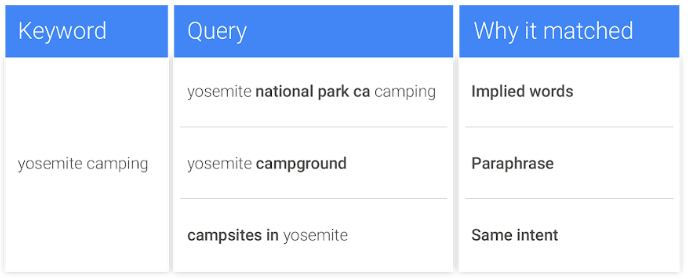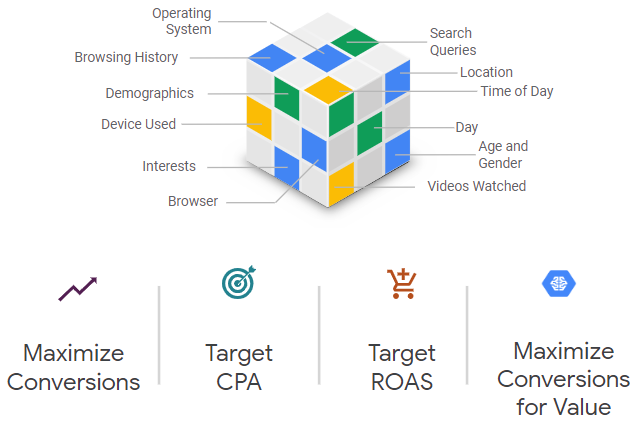For years, search advertising practitioners have abided by the “best practice” of building campaigns with keyword match types (Exact, Phrase, and Broad / BMM) segmented into separate ad groups. But in the age of AI, automation, and close match variants, this “best practice” may no longer hold up.
For those who are unfamiliar with this campaign structure, it refers to creating separate ad groups for your Exact, Phrase, and Broad (or BMM) keywords. Below is an example campaign utilizing this structure:

In this structure, ad groups are segmented not only by keyword theme (Rolls) but also by match type. Additionally, the Phrase and BMM ad groups have directional negatives applied to funnel as much search traffic as possible to the exact match keywords, which is assumed to have the lowest CPCs.
There are even more granular campaign structures out there such as single keyword ad groups (SKAGS) and Alpha Beta. The SKAG structure uses a single ad group for a single keyword by match type so that advertisers can create keyword-specific ad copy and be very specific with their bids. The downside to this structure is that you end up with thousands of ad groups and ads to manage.
Alpha Beta also makes use of the SKAG structure, but differs by segmenting your top-performing queries (alphas) as exact match into their own campaigns while creating another testing ground campaign for all of your other keywords (betas) as BMM. The intention is to mine the search query data of your beta campaigns to find queries to promote to your alpha campaigns. Alpha beta shares the same downsides of a pure SKAG structure with the addition of having to continually promote/demote keywords between alpha and beta campaigns.
Many have argued that these campaign structures produce the most conversions at the lowest cost because they allow advertisers to optimize at a more granular level. These arguments also coincide with a general distrust of Google Ads automation amongst advertisers who want to ‘take back control and tell Adwords what to do.’
However, all of these campaign structure strategies rely on the core assumption that keyword match type segmentation is better for performance. A couple of updates to the Google Ads landscape made us at Seer Interactive question the validity of this “best practice”: Google’s close match variants update; and improvements in smart bidding strategies.
Close Match Variants
In September 2018, Google Ads made major changes to keyword match type functionality with the exact match close variants update. This update made it so that your exact match keywords will match to additional search queries that include “close variations that share the same meaning as your keyword.” Thus, exact match was no longer “exact” and your keywords could show ads on queries that Google deemed to be semantically similar. In July 2019, Google expanded the close variants update to phrase and broad match. Since the July update, Seer has observed increases in search volume as there are now more queries matching your keywords.

So why does this affect your campaign structure? Match type segmented campaign structures were created on the basis that keyword match types functioned the way they did pre-close variants update. We are now seeing the same search queries matching to multiple keywords, and vice versa, across campaigns despite negative keywords. Thus, the “control” advertisers wanted to take back from Google is now deteriorating.
Smart Bidding
Another area of advertising control Google has made updates to is bidding. Since 2010, Google has invested hundreds of millions of dollars into AI and machine learning, acquiring 14 companies in these areas to date. Translating this investment into Google Ads has been a key focus for the company as they have rolled out multiple smart bidding strategies to help meet each of your campaign’s needs and goals. These bidding strategies use hundreds of signals to make real-time auction bids designed to hit your goals. According to Google,
“These algorithms factor in a wider range of parameters that impact performance than a single person or team could compute. “

So why does this affect your campaign structure? Match type segmented campaign structures were created to give the advertiser as much manual control as possible over keyword bidding. The aforementioned campaign structure strategies were designed to allow advertisers to utilize tiered/stacked bidding on top-performing keywords and match types.
However, this approach needs your campaign to be using manual bidding to function as intended. This comes at the opportunity cost of utilizing the power of Google's AI and machine learning capabilities. While some advertisers may be skeptical of smart bidding, the alternative takes a lot of time to execute. According to Google, 80% of digital marketers' time is spent on manual tasks such as bidding, while only 20% is spent on strategy. At Seer Interactive, we strive for the opposite of that ratio.
Initial Testing Results
Because of the many changes to the search advertising landscape, we tested how match type segmentation effects performance with smart bidding across a couple of clients. We will be running a test across all of our clients this quarter, and will be sure to update you with the results.
Client 1
Control = Match Type Segmented Ad Groups
Experiment = Combined Match Type Ad Groups

These are the two-week results from a Google Ads experiment that split traffic 50/50 between the control and experiment. The control represents a campaign with keyword match types segmented by ad group, whereas the experiment represents a campaign with all keyword match types grouped into the same ad groups (ad groups were still segmented by general keyword theme). Both the control and experiment were using enhanced CPC as the bid strategy.
Relative to the control, the experiment drove 17% more conversions and CPA improved by 24%, indicating that grouping all match types together may improve performance for this client.
However, we did see quality score metrics decrease in the experiment, which is probably due to it matching to more search terms than the control campaign.
Client 2
Control = Match Type Segmented Ad Groups (before)
Experiment = Combined Match Type Ad Groups (after)

These are the results from another test that compares performance before and after making the switch from match type segmented ad groups to combined match type ad groups. The tables represent 52 days of data, 26 days before the switch and 26 days after the switch. Both the control and experiment were using enhanced CPC as the bid strategy.
Relative to the control, the experiment improved CTR by 80% and CPCs decreased by 29%.
Although the conversion volume is not statistically significant, improvements in click volume, CTR, and CPCs are promising. Similar to the previous client, we also noticed declines in quality score metrics, particularly ad relevance and expected CTR. Again, this is most likely due to the campaign matching to more search terms than the control campaign.
Conclusion
These initial tests show that campaign structures that segment keyword match types into separate ad groups do not perform as well as campaign structures that combine keyword match types into ad groups when using smart bidding. This is most likely due to the close match variant updates, as well as improvements in smart bidding strategies. It makes one question whether match type segmentation even matters when using Google smart bidding strategies. Seer Interactive plans to expand these tests across all of our clients and will be sure to update you with results.
At the very least, we hope that this blog post makes you question the validity of so-called ‘best practices’ for your Google ads campaign structures. Google has indicated that automation and machine learning are the future for its advertising services. The aforementioned updates in this post have already significantly changed the search advertising landscape, possibly making campaign structure strategies like SKAGs and Alpha Beta obsolete.
As search advertising continues to change, it is crucial to keep testing established strategies and tactics to see if they truly are ‘best practices’. As the late Hans Rosling once said, “let the dataset change your mindset.”
Be sure to sign up for the Seer newsletter to stay up to date on all things digital!


